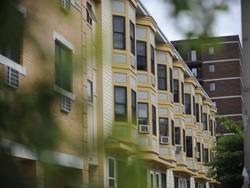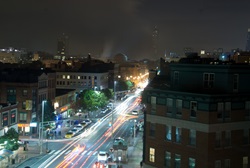Climate Change Planning
 The City Council adopted the Cambridge Climate Protection Plan in December 2002. Both the state and the city have adopted a goal of 80% reductions in greenhouse gas emissions by 2050. Per our participation in the Global Covenant of Mayors, the City has updated the Climate Action Plan.
The City Council adopted the Cambridge Climate Protection Plan in December 2002. Both the state and the city have adopted a goal of 80% reductions in greenhouse gas emissions by 2050. Per our participation in the Global Covenant of Mayors, the City has updated the Climate Action Plan.
The City's planning around climate change focuses on reducing greenhouse gas emissions. When Cambridge began to draft its initial Climate Protection Plan, staff evaluated the relative sizes of the various sources of emissions. The City already had extensive transportation and recycling programs that worked to reduce the community's generation of greenhouse gases. However, we found that most of our emissions are related to buildings, and we did not have programs to reduce building energy use. The Climate Protection Plan, therefore, focuses largely on actions around building-related energy. The Cambridge Energy Alliance was one important initiative. Other building energy initiatives target both existing buildings—much of the City’s building stock is relatively old and inefficient—and new construction, with more stringent energy efficiency requirements. And in 2015, the Net Zero Action Plan was adopted to set Cambridge on the trajectory to eliminating greenhouse gas emissions from the built environment.
As the effect of existing human-derived greenhouse gases already present in the atmosphere has made climate disruption inevitable, Cambridge has concluded that the city should also begin to prepare now for the effects of climate change. With that goal in mind, the City has undertook a Climate Change Vulnerability Assessment and issued the Resilient Cambridge Plan.

Aspects of Cambridge Climate Change Planning
Climate Protection Goals and CCC
 The scientific community advises that the world needs to achieve approximately 80 percent reductions in greenhouse gas emissions by 2050 to avoid the most dangerous disruptions to our climate, and the City Council, following the lead of the Commonwealth, has adopted this goal. Take a look at the Cambridge Climate Protection Plan for details.
The scientific community advises that the world needs to achieve approximately 80 percent reductions in greenhouse gas emissions by 2050 to avoid the most dangerous disruptions to our climate, and the City Council, following the lead of the Commonwealth, has adopted this goal. Take a look at the Cambridge Climate Protection Plan for details.
The Cambridge Climate Committee - CCC - has looked at what that goal would mean, that is, what Cambridge will need to do in order to reduce emissions by 80 percent. The CCC was formerly known as the Climate Protection Action Committee (CPAC). They envision that we will have harnessed the capabilities of residents, businesses, and institutions to transform Cambridge into a city that:
- Comprises energy efficient buildings
- Relies on walking, bicycling, and transit for mobility
- Runs on renewable and non-fossil fuel energy
- Eliminates the generation of waste by closing material loops
- Minimizes the urban heat island effect through increased vegetative cover and reduces heat-absorbing surfaces
- Anticipates and adapts to the impacts of climate change
- Is internationally recognized for climate change education
- Is a center of entrepreneurship for climate change solutions
City staff and CCC are developing objectives and actions that focus on a near-term targets and move the city toward achieving long-term goals. The year 2020 was selected as a target year which is consistent with the Commonwealth’s near-term goal and is not so far off as to be made obsolete by technological and social changes. As circumstances develop, the goals and actions will evolve as well.
Many of the most immediate actions to mitigate climate change have other important benefits: less air pollution, lower energy costs, and a more verdant and healthier community.